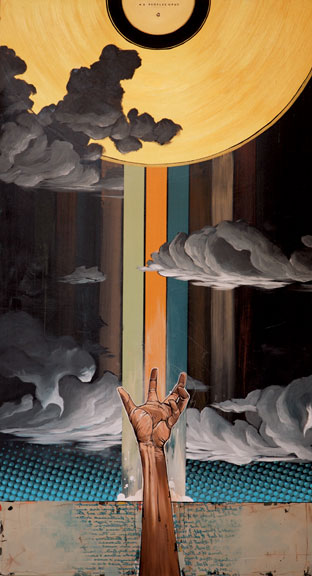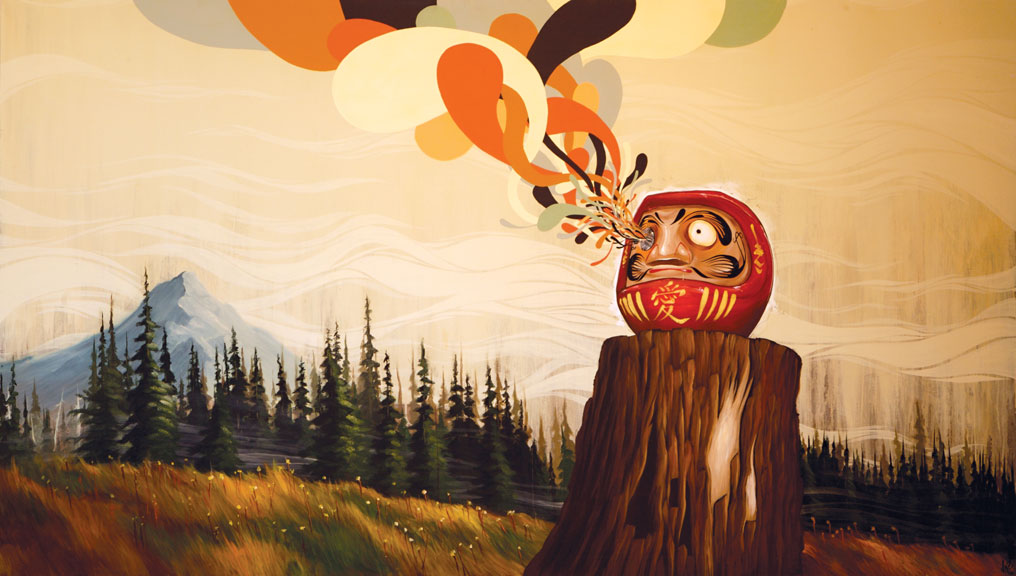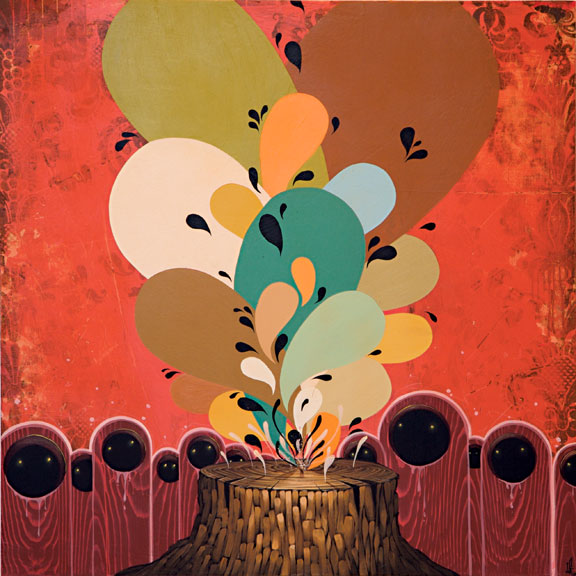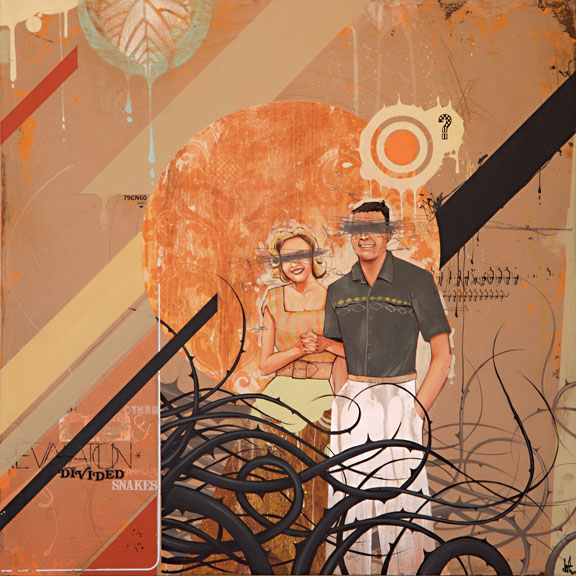After a three year self-imposed hiatus from gallery shows (save a few group show contributions), Blaine Fontana made a comeback last weekend to the gallery scene with his solo show “The Golden Record” at Lebasse Projects in Los Angeles (our pics from the opening here). The exhibition looks to be a triumphal return for Fontana, and is based around humanity and its interface with the universe – the title referencing the information filled golden disks placed on board the Voyager II space craft launched in 1977 that serve as “time capsules” for future space travellers to discover.
We caught up with Blaine on the event of the show to ask him about his break from the gallery circuit, his mark-making techniques and his concept behind the work in the show. Read on for our interview and some more images of the work in the show after the jump.
Arrested Motion (AM): Hi Blaine. Let us all get reacquainted with you. It’s been almost 3 years since your last solo show – where have you been concentrating your efforts in the intervening time?
Blaine Fontana (BF): First, thank you. I’m really glad to be sitting down with you in particular and to have my work featured on Arrested Motion.
It was all about harmonizing my fine art, design, sculpture and woodworking into one glued medium. Although thinking backwards now, I spent a lot of my thoughts and creative pursuits in the design field, professionally and personally. I have always been a designer, but it wasn’t until my break did I approach the medium as a craft I needed to perfect like all those previous years with my fine art. Some of my biggest design projects were quietly being worked on even during those explosive 2006 and 2007 years.
In addition to exploring design, I had the opportunity to build a wood shop at the Bainbridge Island house. My addiction to woodworking began here, in ’07 with the addition of my younger brother, a brilliant architect, designer, and artist in his own right. I was schooled on the jargon, techniques and applications of working with a new medium. I was always painting, but in a snail’s pace and very selectively. It was during these years a significant turning point in my thinking and who I am came to me when I realized I’m not a painter, but a rounded creative, and painting happens to be one of my outlets. Oh, and I almost forgot to mention I’ve been devoting my time academically doing lectures, presentations and my first commencement speech. I was asked in ’08 to join the advisory board for Northwest College of Art in the Puget Sound. This has been a very rewarding experience and satisfies my addiction of giving back to the community and the art world.
AM: You recently moved to Portland – how have you settled in there? Is the artistic community as vibrant as I’ve heard?
BF: Emphatically, YES! Settling in there has been like when the autumn leaves settle into the ground and having the nudity of trees exposed while the detritus from all the leaves fertilize the new saplings. I love the word detritus, it’ll come up again, and everything can be paralleled with trees. Now that I have that cleared up, shall we move forward?
I’m about to break a Portland rule here, never should we discuss with foreigners how cool this place is.
Euegenie (my wife and creative partner) were really overwhelmed early on with the talent there. First, collectively the talent is really good. Second, we would always become exhausted after the first week of each month with 3 art walks all happening within a week of each other. Thirdly, I was overcome with the purism of each artist and the “why” they do it. It was an overdue breath of fresh air from the previous cities I had lived and worked in. So to answer your question, yes it is, and more. Because it’s layered, not with just fine artists, but DIY’ers, designers, and craftspeople also. There’s a style and casualness of everything that is so cool. For instance, Portland has this unique style with homes & businesses that seamlessly integrate old found wood and objects with new minimalism, kinda like an industrial modernity with a bohemian flair. This really speaks to my soul and is a direct reflection of its people and continually keeps me invigorated. I’ve now heard twice in LA on my trip from older folks that feel its the same kind of renaissance like in the late 60’s in SF, to me that’s a bit of an overstatement but does subtly resonate in areas figuratively.
AM: Over the last few years you’ve moved from Long Beach to Bainbridge Island, before recently settling in Portland. Have you noticed a change in in the themes and the inspiration behind your work brought about from the changes in location?
BF: Wood, solitude, and sincerity.
It was in the solitude of the forest where I began my affair with the beauty of wood on Bainbridge. And it was the move into Portland when I rediscovered to integrate the importance of sincerity into my work. By the time I had settled down into Portland, in retrospect, I had exploited all I could from that region in my work from 2002 – 2007. Several years older and hopefully wiser, I developed a new relationship with nature based on social values & problems rather than a spiritual and fantasy one.
AM: Earlier in your career, you were a graffiti artist. What did you write, or was your outdoor work mural based? Are any of your pieces still intact that you know of?
BF: Let the record state that the the defendant has pleaded the “Fizith”.
AM: You seemed to have an unbelievable amount of solo shows through 2006 and 2007, and during those times, a lot of people seemed to get bitten by the Fontana fever! Your popularity soared in a short space of time. Did you feel that you burned yourself out putting all of that work out there during that period, and were there any lessons learned you would care to share?
BF: Six my friend… Six, in four different states, and six different cities, I couldn’t even count the group shows in all the other states & cities. I was such a whore, but I suppose that innocent one who was naively on the streets for the first time, fragile and seduced and got really caught up in it without knowing the consequences. At the time, my thinking was “you have to strike when the iron is hot”, but in hindsight, the mistake I nearly made was destroying the entire smelting refinery as well. I would have done a number of things differently. Less is more. And yes, I crashed at the beginning of ’08. That was embarrassingly caught on the documentary a friend of mine has been working on me for the last 5 years. However it does add a juicy & engaging conflict from a filmmaker’s eye and an honest perspective from mine.
AM: I’ve been enjoying your recent works, especially the mixed media and sculptural pieces you’ve made. Can you tell me a little about the materials you are using and the different techniques you employ?
BF: I’m pulling all the tricks out of the bag for these ones, and the bag just keeps getting bigger. I was so tempted to unleash the sculptures at my recent solo show. But lessons have been learned and will come to light when it is right. I can tell you they marry wood, painting, and the relevance of sustainability. Most of the wood is salvaged from a secret spot in Portland 20 miles out of the city in farmlands. Every imaginable material is available here. Imagine a Home Depot meets swap meet, and prices better than garage sales. Can I have seconds please? One of the materials I discovered there was Malaysian Kuring Wood. Its characteristics are hard to soft and colors ranging from green, dark brown, purple, yellow, and beige. I used these in the ”Polypropylene Detritus” pieces featured at the Together Gallery wood show. This piece also incorporated, acrylics, and miniature trees made purely of plastic designed for train model sets. If you liked that, it’s only the start.
AM: I think that we share a love of typography, as you often use text and type in your compositions. My early interest in type as art stems from my appreciation and absorption within music and the graphic packages used with record covers, and probably started with the work that Peter Saville designed for Factory Records in the 80’s and 90’s. What was it that started your interest and appreciation? Do you have an all time favourite font? What are the qualities that make it stand out for you?
BF: Great impetus for discovering your love for design. I only recently discovered him through the Santogold cover. For me, it was Saul Bass. He was such a prolific designer/artist and such a versatile one, I can only aspire to the achievements he’s made. In fact, I was watching the original Oceans Eleven last night, and I immediately began geeking out on the title credits, only to find out, Saul Bass did them. A side note for you and those reading this, if you are like me and love well crafted title credits and the insight that goes into them, you’ll have to do yourself a favor and follow a blog called “The Art of The Title”.
I’ve been a lover for several years now of the precursor to Helevetica, Bethold Akzidenz Grotesk. A range of emotions, and characteristics, but doesn’t come off as pretentious or played out like Helevetica. I love using the extended light option of this with either really tight kerning or macho city extended out, and a go to body copy font as well. Type for me is like all the girlfriends you had as a young man or teenager, often experiencing them awkwardly, loving them intensely for a short while, but always remain with you as nostalgia. Mrs. Berthold became my wife.
AM: Back in 2006, you were the curator of a group show at Thinkspace gallery in LA entitled ‘The Square Foot’ where you invited 50 artists to produce a 12×12 inch piece of work on boards made and provided by yourself. For me, this remains a stand-out show in terms of artist as curator / curator as artist within the new contemporary scene, and I don’t think I’ve seen as strong a curatorial presence within a group show since then – it seems to be lacking in a lot of more recent group efforts. You’ve also been involved in curating exhibitions at 19ten gallery in Portland in recent times. What are your thoughts on curation within the new contemporary scene and also the importance of artist as curator?
BF: That’s too generous. I will agree however that its also been a favorite of mine. I have to mention one thing though, without the help of Joshua Clay building and finishing all those finely crafted wood boxes with me, I would have never pulled it off. That show has always been on my mind since. The only one that deserved further exploration. In fact, enough to even elaborate on that project for a show in Portland at the Compound Gallery on January 19th. Except this is a solo endeavor with only one very large piece made of many small ones.
I think a curator’s position should be that of a car and the artist(s) as the driver. Some cars will draw more attention, add sophistication, or establish a precedent, but ultimately its no good without a good driver. It would be refreshing to see more artists reverse their roles into curatorial or managing a show. I feel a lot of them might drop the tude’ or re-evaluate they’re professional practices or lack there of. I do it for the love. I love organizing and or hosting events.
My last curated show with the 19TEN gallery was on March 6th with the We Heart PDX prints show, and it ended with a bang. At first, my attentions were to bring something unique to my neighborhood and to show in a beautiful space the amazing contemporary talent that most of the general public wasn’t aware of. It was successful in that regards, and soon became a destination spot. It was really gaining traction when I left, but alas all good things must come to an end, and my plate was already full. I was fortunate to bring in amazing artists like Zach Johnsen, Jesse Reno, and Dan Ness.
AM: The new work you’ve been producing signals a significant step in your artistic output – away from your earlier illustrative approach to a more encompassing fine art setting. Do you still use any of the character-based elements within your work, such as the templings, or has the subject focus changed more into the realms of portraiture and abstraction?
BF: Probably gone forever. I believe they are happily crafting dreams and myths for all the young boys and girls who will be chosen for the next art movement in place between the worlds of now and forever. As far as portraiture and abstraction, that’ll unfold into the work if it needs to but but not solely as a direction. Definitely ingredients, but not direction. This new work has and will continue to have versatility to it, I would be a shame that I stick to only several visual styles. I’ll always sketch characters and will occasionally pop up commercially, but I’ve just developed so much more the last several years and my interests are very different now. If anything, abstraction. But, it will be represented as more intellectual graphic design and composition, rich with reason and story.
AM: Traditionally, you’ve used a lot of recurring motifs in your work, such as the birdhouse, the sunburst, Native American and Asian imagery and of course the numbers 76/09. What significance do these elements of mark-making hold for you?
BF: My own form of prayer. I’m in no way religious, but significantly spiritual. It will be interesting now that I am omitting most of this recognizable content, I’ll have to find a new outlet for these “prayers”.
AM: Your solo show ‘The Golden Record’ opens at Lebasse Projects on 25th April in Los Angeles. The theme is based around the gold records placed on the Voyager spacecraft in 1977 and the information contained therein. Can you elaborate on this a little more? What was it that spurred your interest in this subject and compelled you to produce this theme of work?
BF: I could spend hours discussing this further. So, I would rather you and anyone reading who’s interested to take the same initiative I took and enjoy the same way I enjoyed discovering all this information and amazing footnote in our history as humans. There are numerous articles on line, but the coolest is simply a presentation of the record and its contents, auditory and visual is (www.goldenrecord.org). It will possibly make you feel better as a human being and change your perspective about your responsibility here, for as short as it is.
I needed a catalyst for the show, some visual glue that would bond all the ideas I had about the past, present and future states of humanity. Fortunately, the golden record also provided more content as well. We as a people have sadly lost our romance with space, inventors, scientists, explorers, artisans, and composers. Ask any kid these days who Carl Sagan was, see what happens. Better yet, Neil Armstrong. We have a morbid fascination with people who don’t contribute shit to our planet, and they are the ones who consume most of time when we aren’t working.
AM: I understand that this exhibition is around a years worth of work in the making. How many pieces of work did you create under this theme, and how many of these will be presented within the show?
BF: Conceptually, I’ve been working on this for three years. Some of my notes go further back than that. I loosely started this new body of work back in October ’09. The work that has been presented is all there is, except for a handful of other pieces that have been developed, but not finished that beckon my call back in my studio. Taking on a large scale subject like the potential and trappings of humanity can’t be captured in 13 pieces. It was very difficult to select the topics I addressed; I choose the ones that resonated with me more personally, the others in development are more removed from my opinions and personal attitude. It was at first very awkward knowing I would present only 12 – 15 pieces. I had been so accustomed to showing 25 – 35 pieces at previous solo shows, so it was thrilling to put such unconditional and passionate time and love into these pieces.
AM: The actual golden records served as a time capsule to represent the earth as it was in 1977. Interestingly, the USA chose to represent itself with Chuck Berry’s “Johnny B. Goode” as part of this message in a bottle. Can you select a few items (sounds / images / words etc.) that you feel would better represent our cultural journey as we stand here in 2010?
BF: In perfect SNL form, Steve Martin made a hilarious quip in 1977 about that. As a psychic for the mock news he proclaimed Earth will receive the first official message from extraterrestrials, “Send more Chuck Berry.”
This was the daunting task of Carl Sagan, and one I don’t envy. An incredible honor, but how do you summarize our existence? Musically, I feel it would be appropriate that all countries and or languages represented on the record should be able to choose their own track. As a devoted music lover, so many styles and voices from around the world should be represented. Ethiopian Jazz, Mongolian Overtone singing or commonly called throat singing, unclassifiable music like Massive Attack, American jazz, Jose Gonzales; it’s just to difficult to summarize. But, if my hand were forced, picking an American track, it would be “A Love Supreme” from the “Stolen Moments Red Hot + Cool album” released in 1994. But as a human, it would have to be Horace Andy’s/Massive Attacks “Hymn on a Wheel”.
AM: Thomas Doyle is showing alongside you in the gallery and he uses model pieces to create his atmospheric settings, often with an underlying menace present in the scenarios. You’ve used some similar modeling materials in recent work shown at Together Gallery; what do you think of his work and how do you see his sculptures sitting alongside your paintings in the exhibition?
BF: I think Beau Basse was brilliant pairing us together. Thomas’s work is the real deal and the most unique I’ve seen in a while. He is a very sharp man, grounded and has a pleasant demeanor that only makes his work stronger. Honestly, I feel his work shadowed mine tremendously. The brilliance in Thomas’s arrested realities is how no matter how haunting, tragic, or emotionally tangled, it resonates with everyone. It was an honor to show with him, and am anxiously waiting to see his new works and his career expand tremendously.
AM: What other plans are you conjuring up at the moment? What can we expect to see from Blaine Fontana for the remainder of 2010?
BF: Aaaah, so many things to mention, insert a Captain Kirk accent here… Engage the shameless plug flux resonator reactor overdrive.
As soon as I return to the Bird Nest, I’ll be working on that Compound show I mentioned earlier. A limited watch that will be released through Vannen in a couple weeks. Several books that feature my design/paintings from other very talented individuals from around the globe. We’ll hopefully soon be hosting still life, figure study workshops in our studio. More motion graphic projects with my partner Wyatt in Long Beach, like a documentary on a legendary female Ethiopian Jazz singer. A LOT more sculpture work, and the two big ones, mentioning this for the first time, a new book that will encompass the range of work I do but presented in a classic large, hardbound coffee table book style. Secondly, a documentary that Wyatt Seaverns from Submerge media fame has been working on for the last five years using 8mm, 16mm, HD, timelapse’s and the Red camera.
AM: Many thanks for your time Blaine – best of luck with the show.
BF: No, thank you. These have been some of the most challenging and insightful questions I’ve had the pleasure answering in a while.










